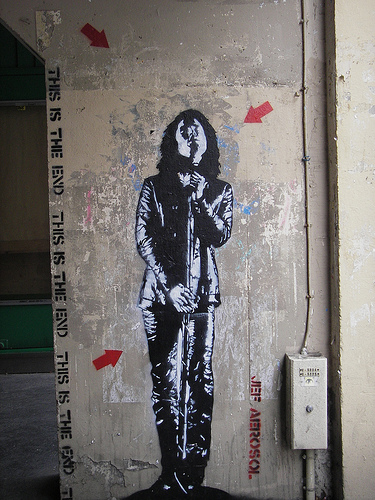art
Contemporary Art and My Problem with "Supposed-To"
I wrote this just before coming home and it's hard for me to post it because I don't want to sound completely ignorant of art. I think my feelings are related to a distaste for the art critic establishment (or what I know of it).
I suppose you’ll say I’m shallow, or cynical or lack sophistication, but I am not moved by the majority of contemporary art I’ve seen lately – particularly multimedia art. Yesterday we went to MACBA (
Over the past year, we’ve both tried to take a de-mystified look at the world we’ve seen and I think it has extended to art in some cases. This means looking at something in terms of what we really see or feel and not what we’re supposed to see or feel. In MACBA, it frustrated me to read the cards by an art expert or the artist that decodes the artist for the layman. An actual example:
Though his oeuvre is difficult to classify in one specific tendency, it possesses a significant conceptual component that expresses displacement and lack of communication and thus a negation of the very existence of contemporary society.
Oh, I get it now. He is negating the existence of contemporary society.
For multimedia art, I don’t want to have to be told that there is a statement about the world hidden in the slides of suburban
Aside from the artist’s peers, art critics and the artists own statements, I wonder how meaning or statements would be derived? How closely would the artist’s vision of the piece translate to those of us that operate outside the art world? And, if meaning is only derived from those privileged few, does it matter that I don’t get it? Is it even supposed to have meaning for me?
Here’s an example. This is a 22 second video from a
Now, consider the exact same video. Only this time, consider this statement:
The artist is clearly making a statement about the closed and oppressed nature of Japanese society. The commuters are being closed off from the rest of the world - even as they are squeezed from every side to fit in behind society’s closing doors. It makes painfully clear the nature of the Japanese experience.
OK, maybe you see it a little differently now, maybe not. You know what though? This is what I was thinking when I shot this video – er, this was my vision for this piece:
I wonder if this is rude to video these people? Man, that train is crowded. I’ve really got to hold this camera still. Oh look, she’s wearing mask - that will be interesting. They are so quiet. It is ever going to leave? I’m getting hungry.
My point is to illustrate how a lot of the contemporary art we’ve seen makes me feel by assigning extraordinary meaning to a video that was never intended to have deep meaning in the first place – it is just a video of people on the subway – right?
Perhaps I lack depth, intellect or an eye for art, but some of it just doesn’t move me and I’m not going to pretend that it does just because its how I’m suppose to feel. The art establish may agree that a piece is a statement about transcendence of gender roles in urban civilizations, but to me, it’s still just pictures of old people in a park. And I am OK with that.
Video: Barcelona's Bizarre Human Statues
You've likely seen the people who paint themselves silver and pose on a box to earn spare change. The folks in Barcelona takes this whole idea to whole new level. The creative, the absurd, the animated, the banal, it's all there and it's all just so weird.
Correction: In the video, I mention an article by a UK paper called the Guardian. I meant to refer to this article in the Independent - not the Guardian.
The Sad and Sometimes Beautiful State of European Graffiti

“The graffiti people should be hanged” – that is what I heard from a business owner in
And so it is for a lot of
I have enough of a counter-culture lean to like some forms of graffiti. It is an art form and there are incredibly talented people who do their work with aerosol cans and public walls. Unfortunately, these are the exceptions. 99% of the graffiti we’ve seen is not an attempt at art, but what appears to be late-night scribbles by disaffected individuals that wish to state publicly their discontent with politics, football, the environment, their personal lives, etc. This is the sad and ugly graffiti that plagues

There is of course, a beautiful side as we saw in

Jef Aerosol, in

In

A few others struck me too.

In
…eliminate dirt, litter, graffiti, animals' excrement and excessive noise from domestic and vehicular music systems in European cities, along with other concerns over urban life.
The sad reality from our perspective is that graffiti appears to be taking over the walls of
Sometimes though, graffiti has a way of stating something that just wouldn't be as appropriate any other way...



